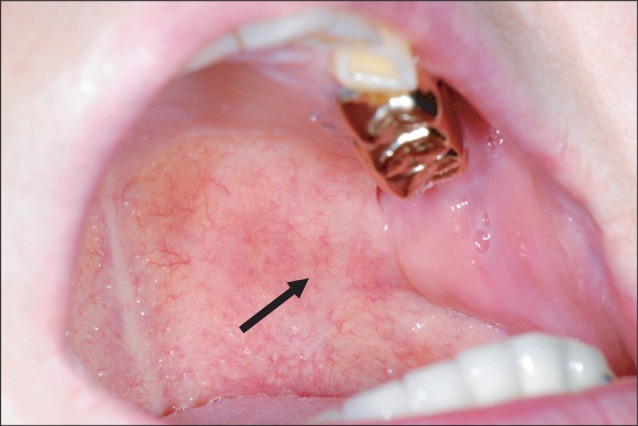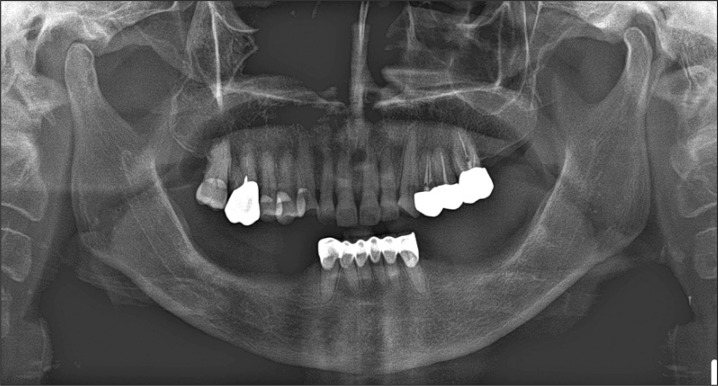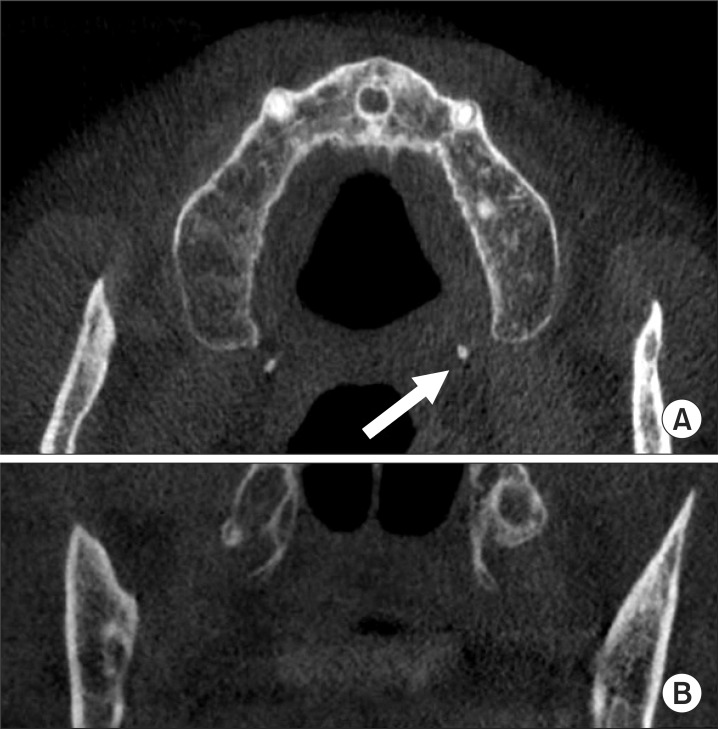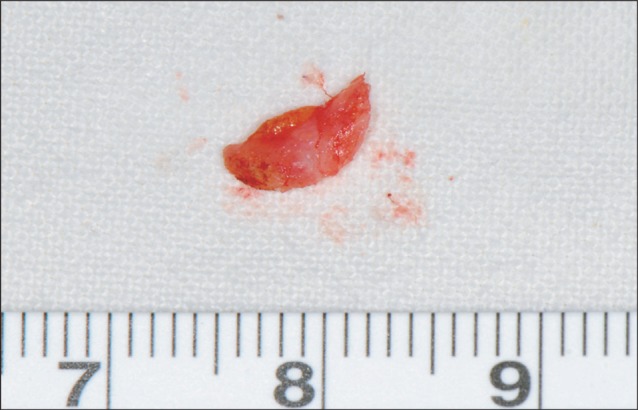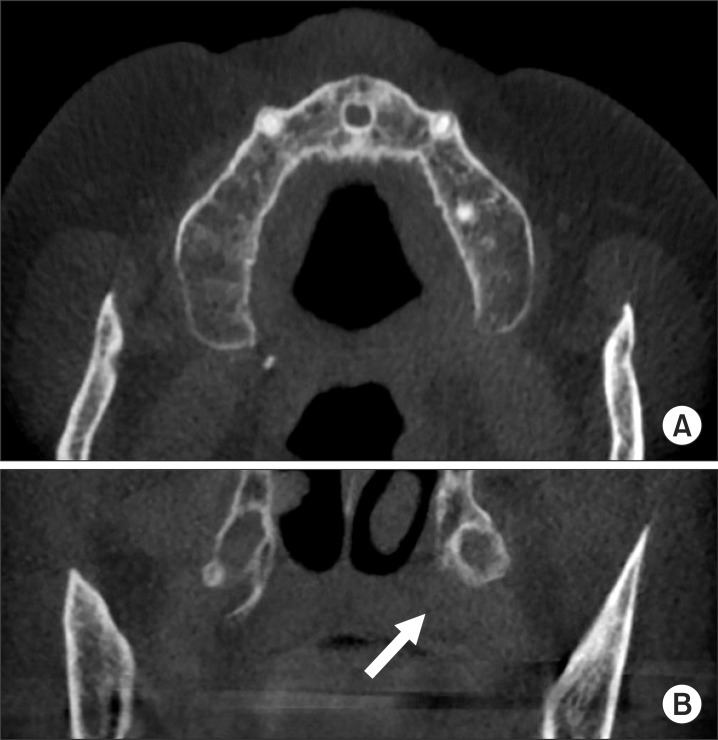J Korean Assoc Oral Maxillofac Surg.
2013 Jun;39(3):134-138. 10.5125/jkaoms.2013.39.3.134.
Pterygoid hamulus bursitis as a cause of craniofacial pain: a case report
- Affiliations
-
- 1Department of Oral and Maxillofacial Surgery, Section of Dentistry, SMG-SNU Boramae Medical Center, Seoul, Korea. neo0224@gmail.com
- 2Department of Oral and Maxillofacial Surgery, School of Dentistry, Chonnam National University, Gwangju, Korea.
- 3Department of Oral and Maxillofacial Surgery, School of Dentistry, Seoul National University, Seoul, Korea.
- KMID: 1430481
- DOI: http://doi.org/10.5125/jkaoms.2013.39.3.134
Abstract
- Pain on the soft palate and pharynx can originate in several associated structures. Therefore, diagnosis of patients who complain of discomfort in these areas may be difficult and complicated. Pterygoid hamulus bursitis is a rare disease showing various symptoms in the palatal and pharyngeal regions. As such, it can be one of the reported causes of pain in these areas. Treatment of hamular bursitis is either conservative or surgical. If the etiologic factor of bursitis is osteophytic formation on the hamulus or hypertrophy of the bursa, resection of the hamulus is usually the preferred surgical treatment. We report on a case of bursitis that was managed successfully by surgical treatment and a review of the literature.
Keyword
MeSH Terms
Figure
Reference
-
1. Ghosh LM, Dubey SP. The syndrome of elongated styloid process. Auris Nasus Larynx. 1999; 26:169–175. PMID: 10214896.
Article2. Love JG. Diagnosis and treatment of glossopharyngeal neuralgia. Ann Surg. 1941; 113:1078–1079. PMID: 17857808.3. Raustia AM, Oikarinen KS, Luotonen J, Salo T, Pyhtinen J. Parotid gland carcinoma simulating signs and symptoms of craniomandibular disorders--a case report. Cranio. 1993; 11:153–156. PMID: 8495508.
Article4. Brooke RI, Stenn PG, Mothersill KJ. The diagnosis and conservative treatment of myofascial pain dysfunction syndrome. Oral Surg Oral Med Oral Pathol. 1977; 44:844–852. PMID: 341019.
Article5. Youniss S. The relationship between craniomandibular disorders and otitis media in children. Cranio. 1991; 9:169–173. PMID: 1802427.
Article6. Shankland WE 2nd. Bursitis of the hamular process. Part I: anatomical and histological evidence. Cranio. 1996; 14:186–189. PMID: 9110609.
Article7. Putz R, Kroyer A. Functional morphology of the pterygoid hamulus. Ann Anat. 1999; 181:85–88. PMID: 10081567.
Article8. Shankland WE 2nd. Bursitis of the hamular process. Part II: diagnosis, treatment and report of three case studies. Cranio. 1996; 14:306–311. PMID: 9110625.
Article9. Gores RJ. Pain due to long hamular process in the edentulous patient. Report of two cases. J Lancet. 1964; 84:353–354. PMID: 14199335.10. Eyrich GK, Locher MC, Warnke T, Sailer HF. The pterygoid hamulus as a pain-inducing factor. A report of a case and a radiographic study. Int J Oral Maxillofac Surg. 1997; 26:275–277. PMID: 9258718.11. Dupont JS Jr, Brown CE. Comorbidity of pterygoid hamular area pain and TMD. Cranio. 2007; 25:172–176. PMID: 17696033.
Article12. Shankland WE 2nd. Pterygoid hamulus bursitis: one cause of craniofacial pain. J Prosthet Dent. 1996; 75:205–210. PMID: 8667281.
Article13. Wooten JW, Tarsitano JJ, Reavis DK. The pterygoid hamulus: a possible source for swelling erythema, and pain: report of three cases. J Am Dent Assoc. 1970; 81:688–690. PMID: 5272119.
Article14. Ramirez LM, Ballesteros LE, Sandoval GP. Hamular bursitis and its possible craniofacial referred symptomatology: two case reports. Med Oral Patol Oral Cir Bucal. 2006; 11:E329–E333. PMID: 16816817.15. Salins PC, Bloxham GP. Bursitis: a factor in the differential diagnosis of orofacial neuralgias and myofascial pain dysfunction syndrome. Oral Surg Oral Med Oral Pathol. 1989; 68:154–157. PMID: 2780016.
Article16. Hertz RS. Pain resulting from elongated pterygoid hamulus: report of case. J Oral Surg. 1968; 26:209–210. PMID: 5237185.17. Kronman JH, Padamsee M, Norris LH. Bursitis of the tensor veli palatini muscle with an osteophyte on the pterygoid hamulus. Oral Surg Oral Med Oral Pathol. 1991; 71:420–422. PMID: 2052325.
Article18. Sasaki T, Imai Y, Fujibayashi T. A case of elongated pterygoid hamulus syndrome. Oral Dis. 2001; 7:131–133. PMID: 11355439.
Article19. Odoi H, Proud GO, Toledo PS. Effects of pterygoid hamulotomy upon eustachian tube function. Laryngoscope. 1971; 81:1242–1244. PMID: 5569676.
Article20. Noone RB, Randall P, Stool SE, Hamilton R, Winchester RA. The effect on middle ear disease of fracture of the pterygoid hamulus during palatoplasty. Cleft Palate J. 1973; 10:23–33. PMID: 4509407.21. Kane AA, Lo LJ, Yen BD, Chen YR, Noordhoff MS. The effect of hamulus fracture on the outcome of palatoplasty: a preliminary report of a prospective, alternating study. Cleft Palate Craniofac J. 2000; 37:506–511. PMID: 11034035.
Article22. Spauwen PH, Hillen B, Lommen E, Otten E. Three-dimensional computer reconstruction of the eustachian tube and paratubal muscles. Cleft Palate Craniofac J. 1991; 28:217–219. PMID: 2069979.
Article
- Full Text Links
- Actions
-
Cited
- CITED
-
- Close
- Share
- Similar articles
-
- Surgical Traetment of Ischiogluteal Bursitis: 3 cases report
- Topography and Morphology of the Medial Pterygoid Muscle for the Surgical Approach of the Mandibular Ramus
- Calcific Subacromial Bursitis In Childhood: A Case Report
- Prepatellar Bursitis Caused by Aspergillosis : A Case Report
- Iliopsoas Bursitis after Transfemoral Coronary Angiography

